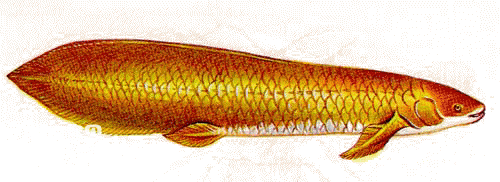The earliest representative of lungfish is the bifin fish of the middle Devonian period. On this basis, lungfishes were relatively prosperous from the Late Devonian to the Carboniferous, and only a few extremely specialized representatives live in the equatorial regions of Africa, Australia, and South America.

bifin fish
Barramundi is the most primitive of the three regional lungfish. They live in a river in Queensland. During the dry season, when the river water decreases, they live in isolated small puddles. They come to the surface to breathe air and use it. A single lung with many blood vessels carries out breathing. However, this fish cannot yet live outside the water.
African and South American lungfish can survive for several months after the rivers in which they live have completely dried up. When the dry season comes, these lungfish dig into the mud and wrap themselves up, leaving only one or several small holes to ventilate to the outside world so that they can breathe. Unlike the barramundi, both species have a pair of lungs.
The ability of lungfishes to breathe air naturally leads us to think that they may be an intermediate link between fish and terrestrial vertebrates. In particular, the paired fins of barramundi have evolved to look like thin legs. They can even use such paired fins to move their bodies like walking in rivers or at the bottom of ponds. This kind of body structure and behavior are very vivid. Reflects the early form of terrestrial four-legged vertebrates.
Compared with other fish families, lungfish have always been an inconspicuous small family. From the backbone of this evolutionary line developed the genus Ceratodon, which was once widely distributed in most of the world's continental waters during the Triassic and subsequent Mesozoic periods. The modern barramundi is a direct descendant of the horned fish.
The lungfish in Africa and the lungfish in South America are side branches that branched off from the evolutionary trunk of the subclass Lungfish. The even fins of African lungfish degenerate into long, thin whip-like shapes, while the even fins of South American lungfish also shrink significantly and become quite small appendages.

Lungfish
The distribution of lungfish on the continents of the Southern Hemisphere has led some geohistorians to believe that this proves that the continents of the Southern Hemisphere were once closely connected in the past. However, some scientists believe that since various lungfishes once spread all over the world during geological history, the distribution of modern lungfishes only represents the modern relics of the once vast lungfish habitats in the past.
The existence of lungfish provides a reference for us to understand the transition from fish to primitive amphibians in the past. However, there is still insufficient evidence to say that lungfish are the ancestors of amphibians. For example, their skulls have a very low degree of ossification, which is very different from the solid bony skulls of amphibians; moreover, the lungs The even fins of fish are so specialized that they appear so delicate that it is difficult to associate them with the strong limbs of amphibians.
animal tags: lungfish
We created this article in conjunction with AI technology, then made sure it was fact-checked and edited by a Animals Top editor.